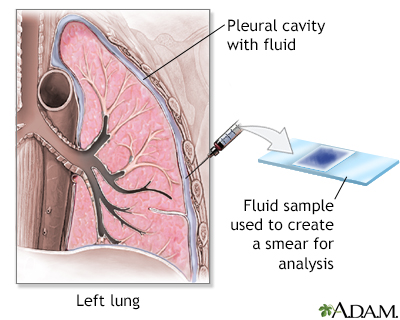Pleural fluid Gram stain
Gram stain of pleural fluid
Pleural fluid Gram stain is a method of staining a sample of fluid taken from the pericardium to diagnose a bacterial infection. This is the space surrounding the lungs. It involves using crystal violet stain to test a sample of the fluid.
The Gram stain method can be used on almost any specimen. It's one of the most commonly used techniques to rapidly identify the type of bacteria causing an infection.
Images

How the Test is Performed
A sample of the fluid can be removed for testing. This process is called thoracentesis. You will have a chest x-ray or ultrasound before the test.
The skin of the chest is cleaned with antibacterial soap. Your doctor then inserts a small needle into the chest between the ribs and into the pleural cavity. A small amount of fluid is taken out.
You may have a chest x-ray after the procedure. Sometimes, the pleural fluid is taken during chest surgery.
A drop of the pleural fluid is spread in a very thin layer on a microscope slide. This is called a smear. The specimen is stained with crystal violet stain and goes through more processing before it is examined under the microscope for bacteria.
The characteristic appearance of the bacteria, such as their color, shape, clustering (if any), and pattern of staining help determine the type of bacteria.
How to Prepare for the Test
No special preparation is needed before the test. A chest x-ray or an ultrasound will probably be done before and after the test.
Do not cough, breathe deeply, or move during the test to avoid injury to the lung.
How the Test will Feel
You will feel a stinging sensation when the local anesthetic is injected. You may feel pain or pressure when the needle is inserted into the pleural space.
Tell your health care provider if you feel short of breath or have chest pain.
Why the Test is Performed
Normally, the lungs fill a person's chest with air. If fluid builds up in the space outside the lungs but inside the chest, it can cause many problems. Removing the fluid can relieve a person's breathing problems and help explain why the fluid built up there.
The test is performed when the provider suspects an infection of the pleural space, or when a chest x-ray reveals an abnormal, usually large collection of pleural fluid. The Gram stain can help identify the bacteria that might be causing the infection.
Normal Results
Normally, no bacteria are seen in the pleural fluid.
Normal value ranges may vary slightly among different labs. Some labs use different measurements or test different samples. Talk to your provider about the meaning of your specific test results.
What Abnormal Results Mean
You may have a bacterial infection in the lining of the lungs (pleura).
References
Martin GJ, Friedlander AM. Bacillus anthracis (Anthrax). In: Bennett JE, Dolin R, Blaser MJ, eds. Mandell, Douglas, and Bennett's Principles and Practice of Infectious Diseases. 9th ed. Philadelphia, PA: Elsevier; 2020:chap 207.
Millington TM, Finley DJ. Pleural effusion and empyema. In: Kellerman RD, Rakel DP, Heidelbaugh JJ, Lee EM, eds. Conn's Current Therapy 2024. Philadelphia, PA: Elsevier; 2024:951-953.
BACK TO TOPReview Date: 10/27/2024
Reviewed By: Laura J. Martin, MD, MPH, ABIM Board Certified in Internal Medicine and Hospice and Palliative Medicine, Atlanta, GA. Also reviewed by David C. Dugdale, MD, Medical Director, Brenda Conaway, Editorial Director, and the A.D.A.M. Editorial team.

Health Content Provider
06/01/2028
|
A.D.A.M., Inc. is certified by URAC, for Health Content Provider (www.urac.org). URAC's certification program is an independent audit to verify that A.D.A.M. follows rigorous standards of quality and accountability. A.D.A.M. is among the first to achieve this important distinction for online health information and services. Learn more about A.D.A.M.'s editorial policy, editorial process and privacy policy. |
The information provided herein should not be used during any medical emergency or for the diagnosis or treatment of any medical condition. A licensed medical professional should be consulted for diagnosis and treatment of any and all medical conditions. Links to other sites are provided for information only -- they do not constitute endorsements of those other sites. © 1997- 2025 A.D.A.M., a business unit of Ebix, Inc. Any duplication or distribution of the information contained herein is strictly prohibited.
